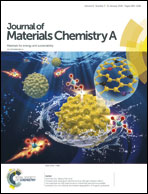Cyanide-metal framework derived CoMoO4/Co3O4 hollow porous octahedrons as advanced anodes for high performance lithium ion batteries†
Abstract
In this work, CoMoO4/Co3O4 hollow porous octahedrons are synthesized by thermal conversion of a cyanide-metal framework (CMF) compound of Co2[Mo(CN)8]·xH2O. As anode materials for lithium ion batteries (LIBs), the CoMoO4/Co3O4 electrodes exhibit a remarkably improved electrochemical performance in terms of large lithium storage capacity (1175.1 mA h g−1 at 200 mA g−1), high initial coulombic efficiency (86.9%), outstanding cycling stability (96.9% capacity retention after 100 cycles) and remarkable rate capability (924.2 mA h g−1 at 2000 mA g−1). The excellent electrochemical performance of the CoMoO4/Co3O4 composite can be ascribed to the hollow porous structure and the possible synergistic effect of different components, which could provide more efficient charge storage sites, shorten ion diffusion and electron transport paths, and accommodate the volume change during cycling. The facile synthesis strategy and excellent lithium storage performance make the CoMoO4/Co3O4 hollow porous octahedrons a promising candidate for high-performance LIB anode materials.



 Please wait while we load your content...
Please wait while we load your content...